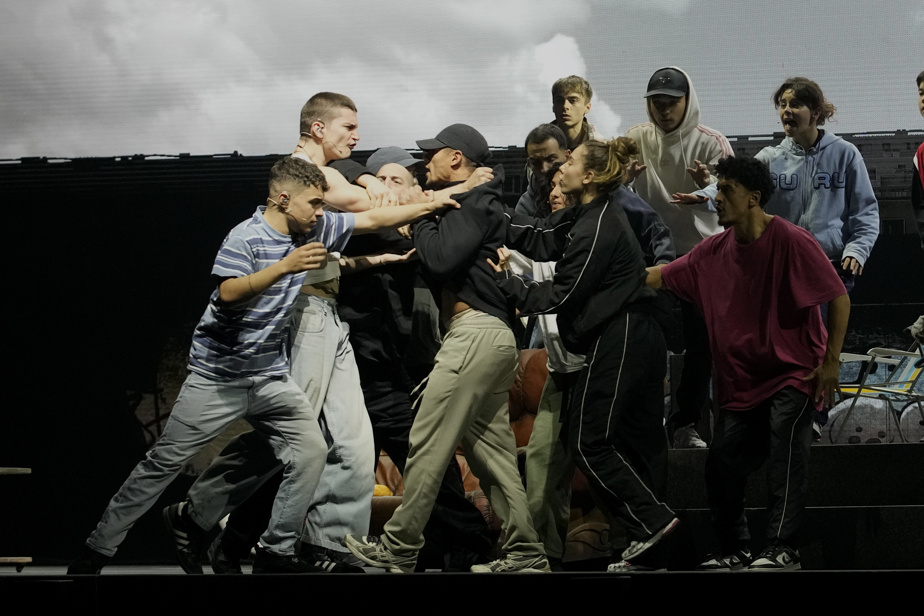While watching Hate Nearly 30 years ago, we felt that violence in the French suburbs was inexorable.
French director Mathieu Kassovitz’s critically acclaimed black-and-white film opens with video footage of urban riots. The film then follows three friends – Hubert, Vinz and Said – for 24 hours in a world of police brutality. It ends with the murder of one of the young men by a police officer.
A confrontation ensues, followed by a voiceover that says, “This is the story of a society falling.” A gunshot rings out, leaving little doubt as to the dramatic outcome.
The film served as a revelation of the harsh reality of life in the French suburbs – deprived areas where council housing is built – and caused a sensation at the 1995 Cannes Film Festival. Kassovitz won the award for best director and “La Haine” became a cult classic in France and around the world.
Nearly three decades later, it is still hailed as the definitive film on the social housing crisis. Kassovitz and Quebec director Serge Denoncourt are giving it new life, transforming it into a musical that will be released in October.
The title remains the same: Hatebut with a subtitle: So far nothing has changed.
“Two days after we announced the show (last year), we were very excited,” Kassovitz said. “We were very happy to say, ‘OK, we’re going to officially announce it and it’s going to be a great show and it’s going to be a great party and everything.’ Two days later, we saw the video of Nahel, you know, the kid who got shot by police.”

PHOTO CHRISTOPHE ENA, ASSOCIATED PRESS ARCHIVES
Mathieu Kassovitz
Kassovitz was referring to Nahel Merzouk, a 17-year-old delivery driver who was shot and killed by a police officer in June 2023, sparking nationwide riots over police brutality, poverty and discrimination against people with immigrant backgrounds. The young man was of North African descent.
“Yes, we know why we’re doing this,” Kassovitz said. “It’s for him. It’s for all the victims who have suffered this kind of violence after so many years.”
The solution: love
Despite the filming of Hate In black and white, Kassovitz tries to avoid overly simplistic conclusions about the roots of violence.
“We are trying to resolve the questions that the film raised,” he explained.
“We can’t just point fingers all the time. Maybe it’s time to find solutions. And we think the solution is love. So that’s what the show is about. It’s about how to stop hating and start loving.”
To find the trio of actors who would carry this message of love through the musical, Kassovitz and his team crisscrossed France for months. The director believes that Aliyou Diop, Samy Belkessa and Alexander Ferrario are the right choices to recreate the film’s alchemy.

PHOTO CHRISTOPHE ENA, ASSOCIATED PRESS ARCHIVES
Aliyou Diop, Samy Belkessa and Alexander Ferrario
For all its darkness, the film already had a dose of lighter moments. It is filled with good lines, funny jokes that only strengthen the bond and love between the three protagonists as they venture into the heart of Paris.
“There’s also a lot of love in the neighborhoods,” said Diop, who comes from a working-class neighborhood in the port city of Le Havre.
“Otherwise, we would shoot each other. In the film, we see three friends living in a complicated context, and we forget the context while watching the film. They manage to make us forget it. That’s why I love them so much. They laugh, they laugh at their misery.”
A better known reality
When Kassovitz made his film, the culture of the French banlieues was still relatively unknown. The local rap music scene had already emerged, but the local mainstream media tended to portray young people from the projects in an unflattering light, an observation based largely on fear.
Kassovitz said he was pleased that some stereotypes had been broken and that young people from the banlieues now had the chance to make their way to the top of the charts, like French-Malian pop star Aya Nakamura, who sang at the opening ceremony of the Paris Olympics this summer.

PHOTO CHRISTOPHE ENA, ASSOCIATED PRESS ARCHIVES
A scene from Hatein rehearsal.
According to him, the difference between the film and the show is that we don’t need to warn people that these are children from the projects. “Thirty years ago, no one knew them, so we had to make a film to introduce them to French culture,” he said.
Diop, who plays Hubert in the musical and is also a rapper, impressed the team with his stage presence. It’s a key asset in a musical that mixes dance, film, rap, theatre and performance and Serge Denoncourt hopes it will be revolutionary.
“We try to put things together in an artistic way, but not too much, too cute. We like the raw material that we have with breakdancing, with rap,” he explained. “The show is pretty raw.”
